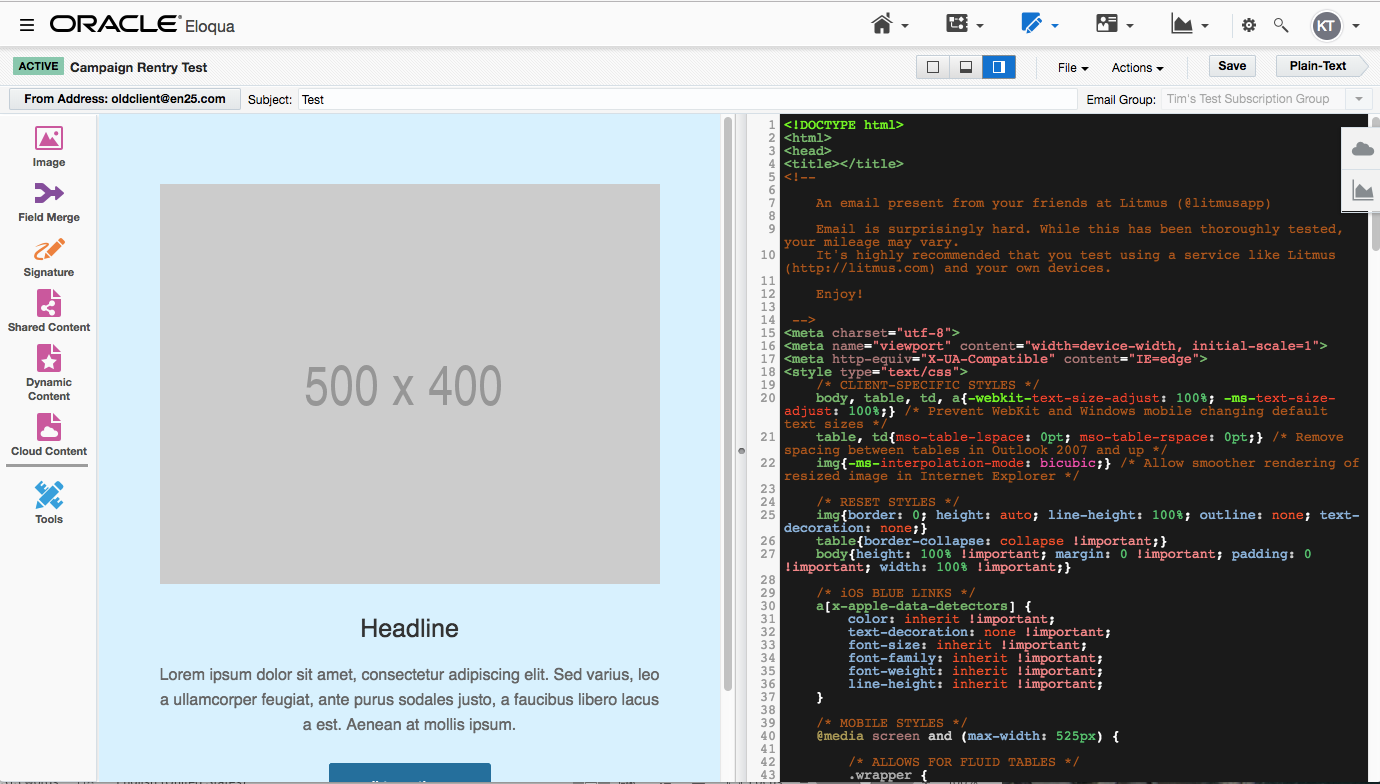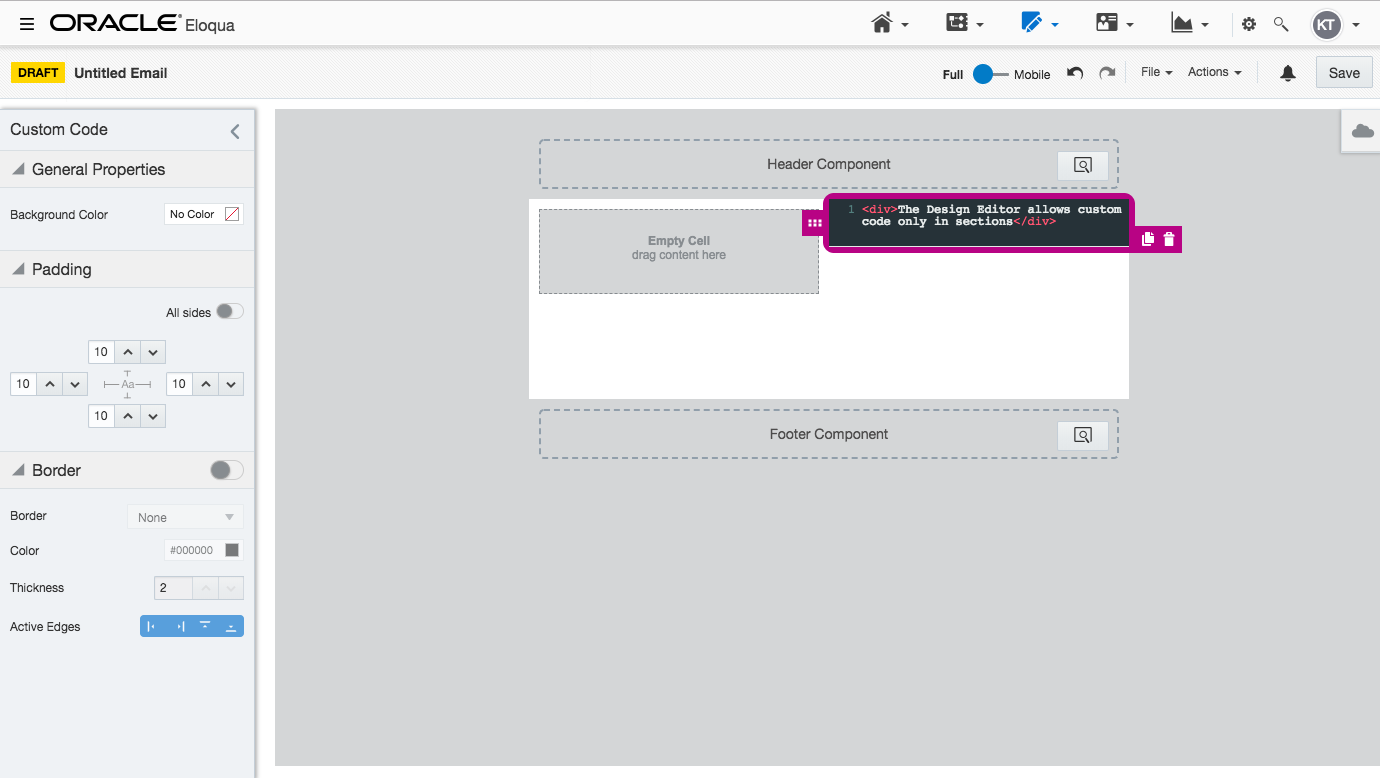One of the first questions people ask when starting out in Oracle Eloqua is whether to create open or closed email templates. Closed templates provide a much more controlled environment, while open templates allow users complete control over the final email asset. There are benefits and disadvantages to both approaches, so in this post I’ll outline the pros and cons, so you can make the right choice for your organization.
Closed Email Templates
With closed email templates, the Oracle Eloqua administrator or template creator decides upfront what areas of the email are editable or can be deleted by the user. This provides a completely stripped-down experience for the email asset creator.
There are three ways to configure editable template sections:
- In the preview pane, right-click areas on the template and mark them as editable.
- In the HTML pane, insert two attributes within the code. By adding elq-edit=”true” and elq-delete=”true” you can define which elements can be edited or deleted. This is only available in the HTML source editor.
- In the new Design Editor, set whether users can change the layout and default style, or change the email design, by going to Protected Content in the Settings
When users create a new Oracle Eloqua email asset from a closed template, sections that can be edited and potentially deleted are highlighted in a broken blue line (See below).

So, are closed email templates suitable for your organization? Here are some of the pros and cons:
Pros:
- Brand compliance and consistency: Closed templates allow you to explicitly define accessible areas of the template. Because of this, administrators and designers can ensure that sensitive areas, such as layouts, logos, or legal disclaimers, are not editable.
- Ease of use / less need for technical know-how: Closed templates provide a bare-bones user interface. All users can do is point and click on editable areas, which takes them to a WYSIWYG interface with access to a limited set of functions, such as image inserts, field merges, and link insertions. Because of this, users immediately know what can be edited and in what way.
- Avoid common coding mistakes: Editing HTML and CSS is pretty straightforward, but it’s more difficult to understand the nuances of how different attributes affect one another. Changing code without understanding the underlying structure can easily damage the email layout. Protected templates restrict access to the underlying code.
- Ensure assets render correctly: There is no standard way that different email clients interpret CSS. Email designers must track these differences and maintain this knowledge as each program releases updates. By limiting access to the CSS, organizations can ensure only qualified people change the templates so they render properly across clients.
Cons:
- Templates become more difficult to edit as designs become more complex: Depending on how many elements are made editable on the template, the more complex the design, the harder it is to edit.
- Need to plan for every use case, as layouts and editable areas are fixed: Closed templates provide a very structured experience, so there’s very little the user can do to customize the email asset. Because of this, administrators must anticipate as many use cases as possible and develop templates for each one. This can result in a great proliferation of templates. This problem can be mitigated by using the new Oracle Eloqua Design Editor to allow users to change the layout – but this comes at the expense of consistency.
- Restrictions on advanced functionality:The stripped-down closed template interface means users do not have access to more advanced features, such as dynamic content, signatures or shared content, unless they are pre-built into the template. Even then, they can’t change out the component for another one of the same type.
- Support for only a limited set of HTML tags:Many users like to use the source editor to create closed templates. Eloqua officially supports a limited set of tags, and using unsupported tags can cause problems, such as using the protected templates in Engage.
- Errors are difficult to diagnose: Because there is no access to the underlying code, there’s no way to quickly correct an email asset. The only method is to debug the template, then rebuild the asset from scratch. Over time, because ISPs change how email clients render messages, you’ll likely need to make repeated updates, which is a pain if you’re trying to get an email out quickly.
Open Email Templates
Truly open templates are only available through the Source Editor, which provides full access to the underlying code (see below). Although the new Design Editor allows users to apply custom code to editable sections, it doesn’t allow you to see or change the overall code (see below).


Many Oracle Eloqua users opt for open templates for the following reasons:
Pros:
- Fully customizable layout and design: Because users have access to the underlying code, users with the appropriate experience have complete control of the email asset. This means the user can create more complex layouts than might be possible using either closed templates or the Design Editor. The user also has greater control over the asset’s responsive behavior.
- Access to advanced functionality: Users have complete access to all of Eloqua’s email tools, such as Dynamic Content, Shared Content, Signature Layouts, and more.
- Quicker deployment: Open templates are less complex than closed templates, so they are easier and faster to deploy.
- Easier to debug: Having access to all the underlying code means if any issues arise, a developer can quickly diagnose and correct the problem.
Cons:
- Detailed processes needed to ensure brand compliance: Because users now have complete control over the email, Eloqua administrators will have to implement more business procedures to ensure that outgoing emails meet brand standards.
- Steeper learning curve: The user interface includes the full array of Oracle Eloqua email components, which can be daunting at first. It’s less intuitive, which means new users will have to learn what everything does.
- Easier to break the layout: Making small changes to the HTML or CSS code can have dramatic and sometimes unpredictable effects, especially when it comes to how the email renders in different email clients. Coding for Gmail and Outlook can be especially tricky. Because the underlying code is accessible, some users might make small changes without realizing the wider effects that may have.
Ultimately, each organization is different. Some find that closed templates are best for them, some decide on open templates, while other may use a mixed approach. Hopefully, this will help you decide which option best suits your team’s needs. If you’d like a more in-depth discussion on what could work best for you, feel free to reach out.






